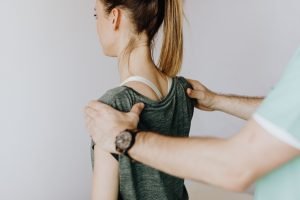
What is Frozen Shoulder?
Frozen shoulder, also known as adhesive capsulitis, is a very common condition that often results from an injury, fracture, surgery, or even happens spontaneously! The condition is characterised by a reduction in range of motion due to adhesion formation in the glenohumeral capsule. Progression of the condition will lead to further decreases in shoulder range. Frozen Shoulder can be of two natures:
– Primary; where onset is idiopathic, or
– Secondary; where onset is due to predisposing factor or event that is surgical in nature.
Pathologically, the antero-superior joint capsule, coracohumeral ligament, and axillary recess is affected. This may be accompanied with rotator cuff contracture and is a large component of the loss of range. Early stages of the condition may be hard to differentiate from other shoulder conditions (Brue et al., 2007).
Frozen Shoulder progresses through the following stages (Dias et al., 2005):
Freezing
- Sharp pain
- Minimal decrease in range of motion
- Pain at night
- Can last anywhere from 2-9 months
Frozen
- Pain decreases and is typically only present at movement extremes
- Range of motion decreases at glenohumeral joint
- Can occur around month 4 and last up to or around a year
Thawing
- Range of motion progressively returns to joints spontaneously
- Improvements may be gained over a 5-24 month period
Clinical Signs & Symptoms of Frozen Shoulder
- Characterized by pain, followed by restrictions of active and passive range of motion
- Feels worse at night
- Aggravated activities include reaching, overhead, or reaching across activities
- May present with a “capsular” range of movement pattern, meaning a more limited range in external rotation than abduction, which is more limited than internal rotation (i.e. external rotation limitation > abduction limitation > internal rotation limitation) (Mitsh et al., 2004).
Risk factors
- Increased incidence with those who have had previous shoulder injuries
- More common with pre-existing conditions such as:
– Hyperthyroidism
– Hypothyroidism
– Diabetes
– Heart disease
– Parkinson’s disease
– Stroke
– Metastatic disease
- Women over 40 are at the highest risk of developing this condition, as well as those recovering from a mastectomy.
Treatment of Frozen Shoulder
- Exercise has been shown to decrease symptom and stage duration, but definitive, evidence-based treatment for the condition remains indistinct.
- Proprioceptive neuromuscular facilitation (PNF) has been shown by Tedla & Sangadala (2019) to be effective in decreasing pain, improving range of movement, improving function, and reducing disability.
– PNF can assist with muscle strength improvements through rhythmic initiation, rhythmic stabilisation, and repeated contractions (Tedla & Sangadala, 2019).
– PNF can assist with muscle flexibility improvements through reciprocal innervation (contract-relax, hold-relax) and post-isometric relaxation (isotonics) (Tedla & Sangadala, 2019).
– Dosages for these techniques were once daily, 2-5x/week, for 3-4 weeks.
- For patients with minimal pain improvement and intolerable symptom management after 12 weeks of conservative treatment, a surgical orthopaedic review might be indicated (Ramirez, 2019).
Resources:
- Brue,S. et al. (2007). Idiopathic adhesive capsulitis of the shoulder: A review. Knee Surg Sports Traumatol Arthrosc, 15:pg 1048-1054.
- Dias, R., Cutts, S., & Massoud, S. (2005). Frozen Shoulder. BMJ, 331: 1453-6. DOI: 10.1136/bmj.331.7530.1453
- Mitsh, J., Casey, J., McKinnis, R., Kegerreis, S., & Stikeleather, J. (2004). Investigation of a consistent pattern of motion restriction in patients with adhesive capsulitis. Journal of manipulative therapy 12: 155-159.
- Ramirez, J. (2019). Adhesive Capsulitis: Diagnosis and management. American Family Physician, 99(5): 297-300. Retrieved from:
https://www.aafp.org/afp/2019/0301/p297.html#afp20190301p297-b13
- Tedla, J. S., & Sangadala, D. R. (2019). Proprioceptive neuromuscular facilitation techniques in adhesive capsulitis: a systematic review and meta-analysis. Journal of musculoskeletal & neuronal interactions, 19(4), 482–491. Retrieved from:
https://www.ncbi.nlm.nih.gov/pmc/articles/PMC6944810/
